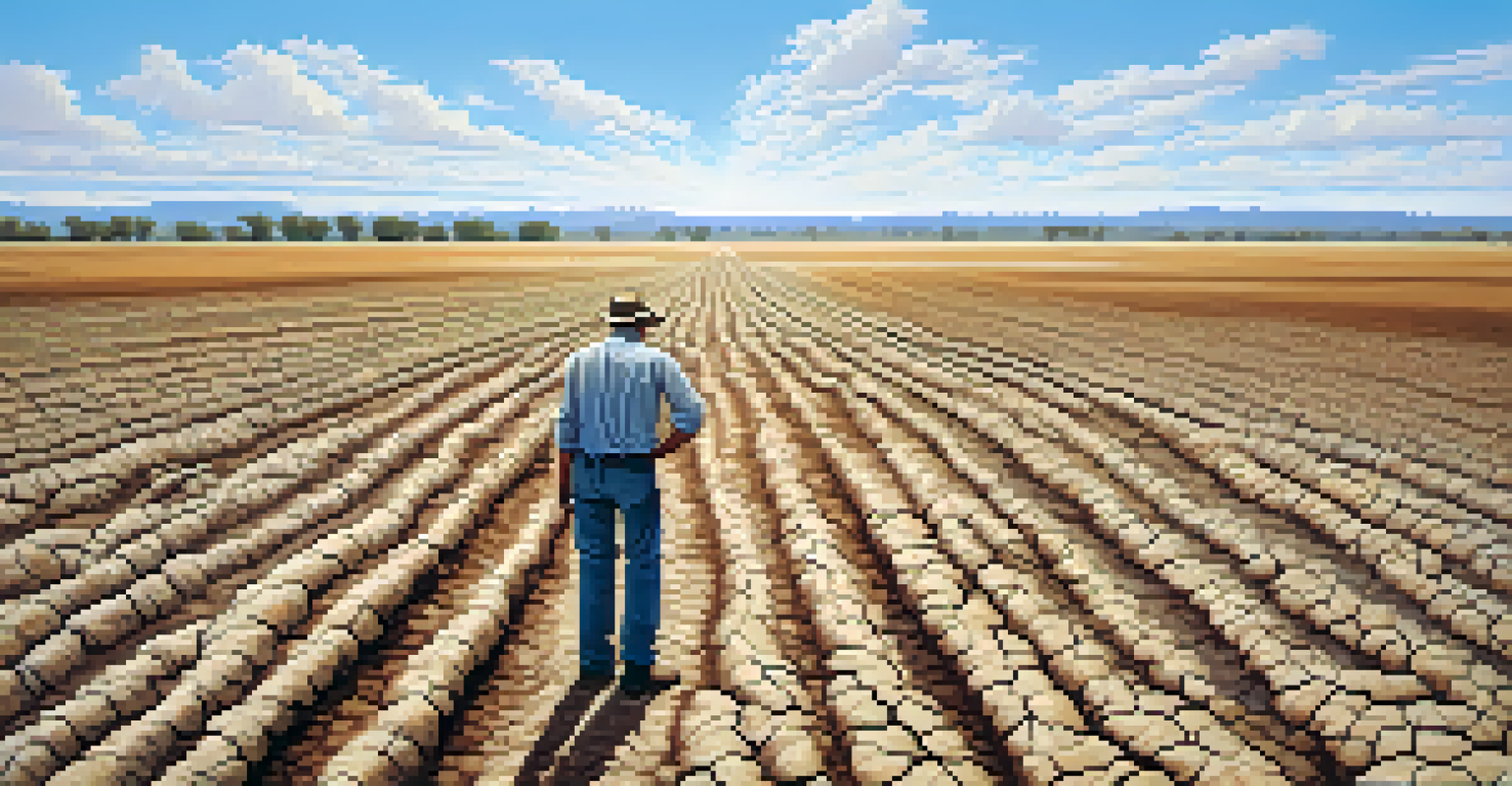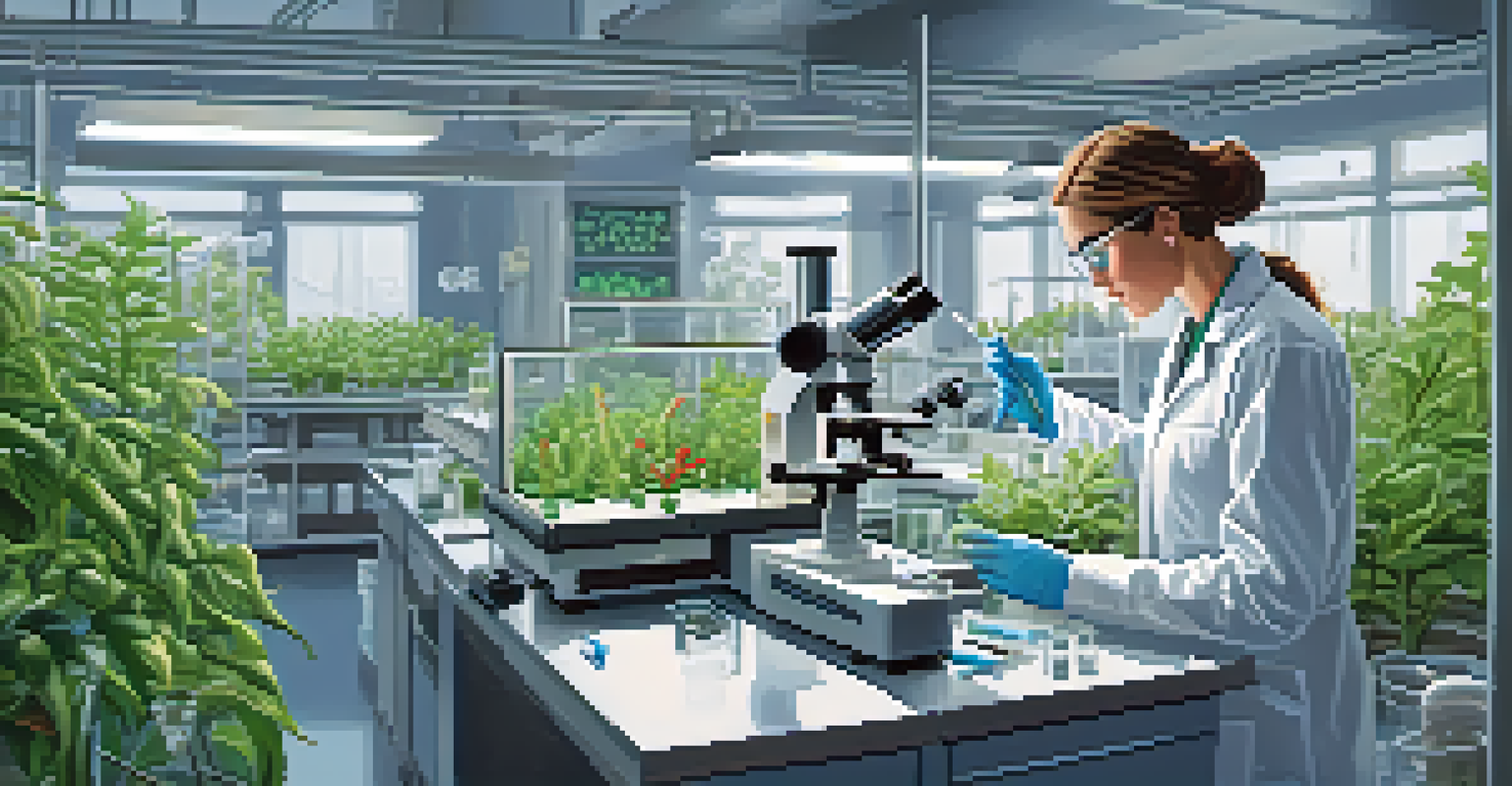Understanding Plant Stress Responses to Environmental Changes

What is Plant Stress and Why Does it Matter?
Plant stress refers to the challenges that plants face from their environment, such as drought, extreme temperatures, and nutrient deficiencies. Understanding these stressors is crucial because they can significantly impact plant health and agricultural productivity. When plants experience stress, they activate a series of responses to cope with these challenges, much like how humans react to difficult situations.
Plants are like people; they feel stress, and it can affect their growth and productivity.
These responses can include changes in growth patterns, leaf shedding, or even the production of protective chemicals. By studying how plants respond to stress, scientists can develop strategies to enhance resilience in crops, ensuring food security in changing climates. This knowledge is not only vital for agriculture but also for conserving natural ecosystems.
Moreover, recognizing the signs of plant stress can help gardeners and farmers make informed decisions about irrigation, fertilization, and pest control. Just as we monitor our health for warning signs, keeping an eye on plants' stress responses can lead to healthier, more productive gardens and farms.
Types of Environmental Stressors Affecting Plants
Plants encounter various environmental stressors, including abiotic factors like drought, salinity, and temperature extremes. For instance, a prolonged lack of water can lead to wilting and reduced photosynthesis, severely impacting a plant's growth. Similarly, excessive salt in the soil can hinder a plant's ability to absorb water, leading to dehydration and nutrient deficiencies.

Biotic stressors, such as pests and diseases, also play a significant role in plant health. These stressors can weaken plants, making them more susceptible to environmental challenges. Understanding the different types of stressors helps in developing targeted approaches to mitigate their effects.
Understanding Plant Stress is Key
Recognizing and addressing plant stressors is essential for maintaining plant health and ensuring agricultural productivity.
By identifying these stressors early on, farmers and gardeners can implement strategies to protect their plants. For example, using drought-resistant varieties or incorporating organic matter into the soil can help alleviate some of the challenges posed by environmental stress.
How Plants Detect Stress and Respond
Plants have evolved sophisticated mechanisms to detect stressors in their environment. They utilize various signaling pathways to sense changes like drought or temperature fluctuations. One example is the production of specific hormones, such as abscisic acid, which play a critical role in signaling water stress and initiating protective responses.
The greatest threat to our planet is the belief that someone else will save it.
Once a stressor is detected, plants activate defense mechanisms, which can include closing stomata to conserve water or redirecting energy from growth to stress mitigation. This process is akin to how athletes adjust their training regimen when facing an injury; they focus on recovery to come back stronger. This adaptability is vital for their survival.
Furthermore, these responses can sometimes lead to a phenomenon known as 'acclimatization,' where plants become better equipped to handle future stressors. By learning how plants adapt, we can apply similar principles to improve agricultural practices and enhance crop resilience.
Physiological Changes in Response to Stress
When under stress, plants undergo various physiological changes, including alterations in their metabolism and growth patterns. For example, during drought conditions, plants may reduce their leaf area to decrease water loss, which can impact their overall productivity. This trade-off is a survival strategy that highlights plants' ability to prioritize their immediate needs.
Additionally, stress can trigger the production of protective compounds, such as antioxidants, which help combat cellular damage caused by stress. These compounds act like a shield, protecting the plant from harmful effects. Understanding these physiological adaptations can aid in developing more resilient plant varieties.
Genetics Enhance Stress Tolerance
Breeding plants with specific genetic traits can significantly improve their resilience to environmental stressors.
These changes also provide insight into how plants can be managed under stress conditions. For instance, selecting crop varieties that maintain productivity under drought can greatly enhance food security in arid regions. Knowledge of these physiological responses equips growers with the tools to make better decisions in challenging environments.
The Role of Genetics in Plant Stress Tolerance
Genetics plays a crucial role in determining how plants respond to environmental stress. Certain plant varieties have evolved specific traits that enhance their ability to tolerate harsh conditions. For example, some crops have developed deeper root systems, allowing them to access water from lower soil layers during droughts.
Scientists are now harnessing this genetic diversity to breed plants that can withstand various stressors. This process involves selecting parent plants with desirable traits and crossbreeding them to produce offspring with enhanced resilience. The use of genetic tools and biotechnologies accelerates this process, enabling the development of stress-tolerant varieties more efficiently.
Ultimately, understanding plant genetics opens up new avenues for improving agricultural practices. By cultivating plants that are better suited to withstand stress, we can ensure more sustainable food production in the face of climate change and other environmental challenges.
Impact of Climate Change on Plant Stress Responses
Climate change is reshaping the landscape of plant stress responses across the globe. Rising temperatures, altered precipitation patterns, and increased frequency of extreme weather events are all contributing to heightened stress on plants. As these changes occur, plants are forced to adapt quickly or risk declining health and productivity.
For instance, some plants may struggle to cope with prolonged heatwaves, leading to reduced yields in crops like wheat and maize. This scenario highlights the importance of understanding how climate change impacts plant physiology and stress responses. By studying these effects, researchers can better predict which species or varieties will thrive in future conditions.
Climate Change Intensifies Plant Stress
The effects of climate change are increasing the stress that plants face, necessitating adaptive strategies in agriculture.
Furthermore, acknowledging the interplay between climate change and plant stress responses can inform conservation efforts and agricultural practices. By selecting and promoting resilient plant varieties, we can help mitigate the adverse effects of climate change and support sustainable food systems.
Strategies for Mitigating Plant Stress in Agriculture
Farmers have a variety of strategies at their disposal to mitigate plant stress and enhance resilience. Implementing practices such as crop rotation, mulching, and cover cropping can improve soil health and reduce the impact of stressors. These practices not only support plant growth but also contribute to a more sustainable agricultural system.
Additionally, the use of precision agriculture technologies allows farmers to monitor environmental conditions and plant health closely. By utilizing data-driven insights, farmers can make timely interventions, such as adjusting irrigation schedules or applying fertilizers, to support plants under stress. This proactive approach is akin to having a fitness tracker for plants, ensuring they get the care they need.

Moreover, collaborating with researchers and extension services can provide farmers with valuable resources and knowledge about stress-mitigation strategies. Together, these efforts can lead to more resilient agricultural systems capable of withstanding the pressures of a changing environment.